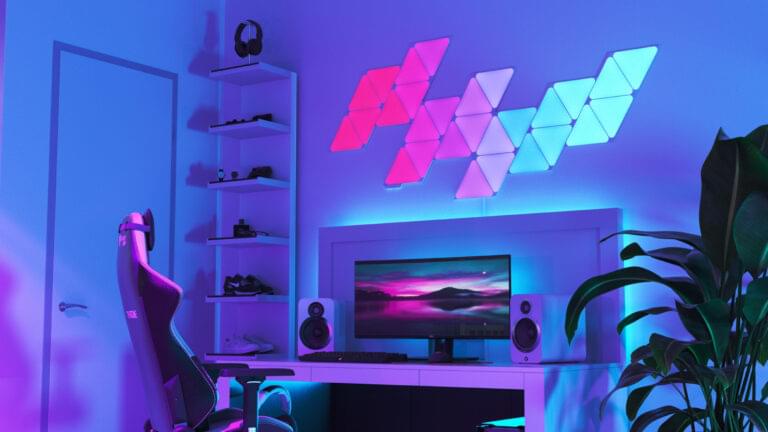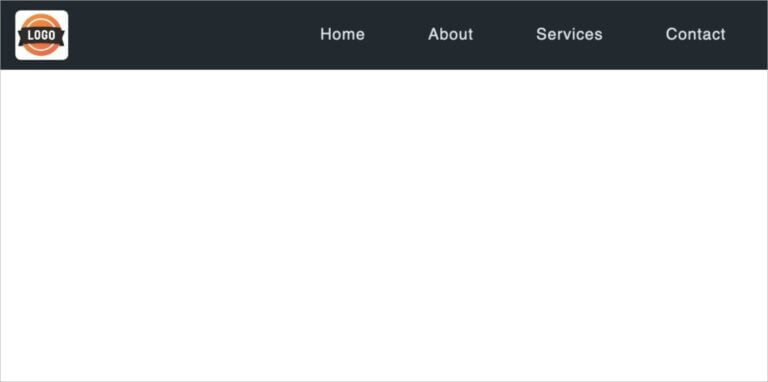Like the weight of a good pen or the balance of a chef’s knife, you can appreciate the quality of a mechanical keyboard just by using it. The stability of the metal casing, the confident click of the keys, and the playful ambience of the RGB backlighting invite you to type.
A keyboard is one of a developer’s primary tools, so get a good one. You need one that’s reliable, feels comfortable, and makes you productive. It’s a choice that deserves the investment of some time and money.
Developers Deserve a Better Keyboard
Table of Contents
Everyone can benefit from a mechanical keyboard, but they’re particularly suitable for developers because you spend a great deal of time typing.
They use mechanical switches that inspire more confidence than squishy membrane keyboards. They leave no doubt when you’ve pressed a key, and many people type faster and more accurately because of it.
They’re also better for your health, especially if you’re a heavy typist. They have longer travel that requires your fingers to move through a greater distance to complete a keystroke, requiring less force.
If you find yourself typing for hours at a time, you’re much less likely to develop strain injuries using a mechanical keyboard.
This article contains affiliate links to products. We may receive a commission for purchases made through these links.
What to Look for in a Mechanical Keyboard
Here are a few things you should weigh up when choosing a mechanical keyboard.
Select the right keyboard layout
One of the most appealing things about mechanical keyboards is that there is so much variety. That starts with the keyboard layout. You choose whether to include function keys, cursor keys, a numeric keypad, and more.
For example, you might want dedicated media keys or programmable macro keys. You may need a numeric keyboard, or prefer the smaller size of a keyboard without one.
Here are the main keyboard layouts used by mechanical keyboards:
- 100% or full-size, typically 104 keys, including the alpha block, function keys, cursor keys, numeric keypad.
- 80% or TKL (tenkeyless), typically 87 keys including the alpha block, function keys, cursor keys.
- 75%, typically 82 keys including most of the keys on a TKL keyboard combined into a single block to be more compact.
- 65%, typically 68 keys including just the alpha block and most cursor keys.
- 60%, typically 60 keys and the alpha block only.
- 40%, typically 49 keys made of a minimal alpha block layout where many keys serve two functions and require the use of a second key.
In this roundup, I’ve assumed most developers prefer lots of keys on their workhorse keyboard and recommend 100% or TKL. However, if you prefer something more portable, most keyboard manufacturers offer a range of sizes.
The choice of switches determines your typing experience
Many developers agonize over the choice of mechanical switches, because this makes the greatest difference to how your keyboard will feel and sound. While you may find the descriptions below helpful, you’ll make a much better choice if you can find a way to test the different switches in person.
Here are some of the more popular brands of mechanical switches and the main switch types that are available.
Cherry MX Switches (used by Corsair, Kinesis):
- Red switches are linear
- Brown switches are tactile
- Blue switches are clicky
Gateron Switches (used by SteelSeries, Keychron):
- Red and yellow switches are linear and quiet
- Blue and green switches are clicky
- Brown switches are tactile and gentle
- Black switches are linear and gentle
- White switches are linear and quiet
Outemu Switches (used by Redragon):
- Brown switches are tactile
- Blue switches are tactile and clicky
- Red and black switches are linear
Logitech, Razer and HyperX make their own range of mechanical switches.
Some companies, like Razer and Gateron, offer optical switches. They’re faster because they communicate keystrokes using infrared light rather than an electrical contact. They’re ideal for gaming, but probably don’t offer any real benefit when coding.
So far, we’ve just described the switches. The actual keys that are attached to the switches are called “key caps”, and they can usually be switched out as well. Many colors and styles are available if you want to personalize your keyboard.
High profile or low profile
Most mechanical keyboards use high profile keys with long travel, meaning that your fingers need to move further to press the keys down. These make it less likely to encounter repetitive strain injury.
However, if you’re used to normal laptop keys, it may take time to get used to this. As a result, Gateron, Logitech, and Razer all offer low profile mechanical switches. These come midway between high profile switches and laptop keyboards.
Programmable keys and macros
Many developers want to personalize their typing experience by creating macros and alternate keyboard layouts. Some keyboards, like the Corsair K100 and Logitech G915, offer additional keys that can be used to trigger your macros.
And although there are plenty of scripting and macro applications available, many mechanical keyboards come with their own software:
- Razer Blackwidow Elite: Razer Hypershift software
- Corsair K100: iCUE application
- Kinesis Advantage 2: SmartSet programming engine
- SteelSeries Apex Pro: SteelSeries Engine
- HyperX Alloy Elite 2: HyperX NGENUITY software
Finally, a small number of keyboards, such as the Logitech G915, come with onboard memory to store and run your macros directly from the keyboard. You can then rely on your macros to work no matter which computer you’ve plugged your keyboard into.
Weight may be important to you
If your keyboard is just going to sit on your desk, then weight won’t be an issue. But if you want a portable keyboard, it may be one of the deciding factors.
Here are the weights of the keyboards included in this roundup, sorted from lightest to heaviest:
- Keychron K1: 2.1 lbs (0.95 kg)
- SteelSeries Apex Pro: 2.14 lbs (0.97 kg)
- Kinesis Advantage 2: 2.2 lbs (1.0 kg)
- Logitech G915: 2.26 lbs (1.025 kg)
- Redragon K556: 2.60 lbs (1.18 kg)
- Corsair K100: 2.89 lbs (1.31 kg)
- HyperX Alloy Elite 2: 3.31 lbs (1.5 kg)
- Razer Blackwidow Elite: 3.69 lbs (1.67 kg)
Wired or wireless
Most mechanical keyboards are wired. This has benefits, such as less latency, resulting in a more responsive experience. It also means you’ll never have to charge a battery, and that could be an issue given that most mechanical keyboards are backlit.
If you use your keyboard with the same computer at the same desk every day, there’s little downside to using a wired keyboard.
However, some companies do offer wireless mechanical keyboards. We only include two in this roundup:
- Logitech G915 (30 hours battery)
- Keychron K1 (10 hours battery)
These keyboards can also be plugged in to your computer and use USB bus power. To maximize the battery life when using them wirelessly, you may wish to dim or disable the backlight.
Many keyboards offer additional features, such as a wrist rest or detachable cable. Some offer USB passthrough ports for easy connection of your peripherals. Most include programable RGB backlighting that looks great when you’re working late.
High ratings from users and testers
While consumer reviews and ratings are never 100% reliable, it’s useful to take into account the feedback from real users and experts who have conducted comparative testing.
Here are consumer ratings (out of 5 stars) for each keyboard by general users who may not be considering the suitability of the keyboard for programming in particular. The list is sorted with the highest-rated keyboards on top:
- SteelSeries Apex Pro: 4.8 stars, 11,219 reviews
- Corsair K100: 4.8 stars, 1,540 reviews
- HyperX Alloy Elite 2: 4.8 stars, 686 reviews
- Razer Blackwidow Elite: 4.7 stars, 5,327 reviews
- Logitech G915: 4.7 stars, 1,371 reviews
- Redragon K556: 4.6 stars, 5,898 reviews
- Kinesis Advantage 2: 4.5 stars, 343 reviews
- Keychron K1: 4.3 stars, 337 reviews
RTINGS is a popular review site that has conducted careful tests on a wide range of mechanical keyboards. Here are their ratings (out of 10) on their suitability for programming, sorted from highest to lowest:
- Razer Blackwidow Elite: 8.2
- Corsair K100: 8.2
- Kinesis Freestyle Edge: 8.0
- SteelSeries Apex Pro: 8.0
- HyperX Alloy Elite 2: 7.6
- Logitech G915: 7.6
- Keychron K1: 7.4
- Redragon K556: 6.9
Gamers may also be interested in RTINGS gaming rating (also out of 10):
- Razer Blackwidow Elite: 9.5
- Corsair K100: 9.5
- SteelSeries Apex Pro: 9.5
- HyperX Alloy Elite 2: 9.2
- Logitech G915: 9.2
- Kinesis Freestyle Edge: 9.0
- Keychron K1: 8.0
- Redragon K556: 7.9
Price
Since you’re purchasing a tool that will make a significant impact on your health and productivity, price shouldn’t be the most important factor when you make your choice.
But if you’re unfamiliar with mechanical keyboards and want to spend some time using one before investing a lot of money, you might like to choose one of the more affordable models.
Here are the list prices of the keyboards in this buyer’s guide, starting with the most affordable:
- Redragon K556: $69.99 list, check price on Amazon
- Keychron K1: $99.00 list, check price on Amazon
- HyperX Alloy Elite 2: $199.85 list, check price on Amazon
- Razer Blackwidow Elite: $169.99 list, check price on Amazon
- SteelSeries Apex Pro: $209.99 list, check price on Amazon
- Corsair K100: $229.99 list, check price on Amazon
- Logitech G915: $249.99 list, check price on Amazon
- Kinesis Advantage 2: $349.00 list, check price on Amazon
The Best Mechanical Keyboards for Developers
Here are the best mechanical keyboards for developers. Make sure you take your own needs and preferences into account.
Razer Blackwidow Elite (wired)
If you’re looking for the best no-compromise mechanical keyboard for developers, the Razer Blackwidow Elite is it. It comes with a premium price ticket, and it’s the heaviest keyboard on our list due to its military-grade metal construction.
- Backlit: RGB
- Wireless: No
- Keyboard layout: 100% with dedicated media keys
- Weight: 3.69 lbs (1.67 kg)
- Price: $169.99 list, check price on Amazon
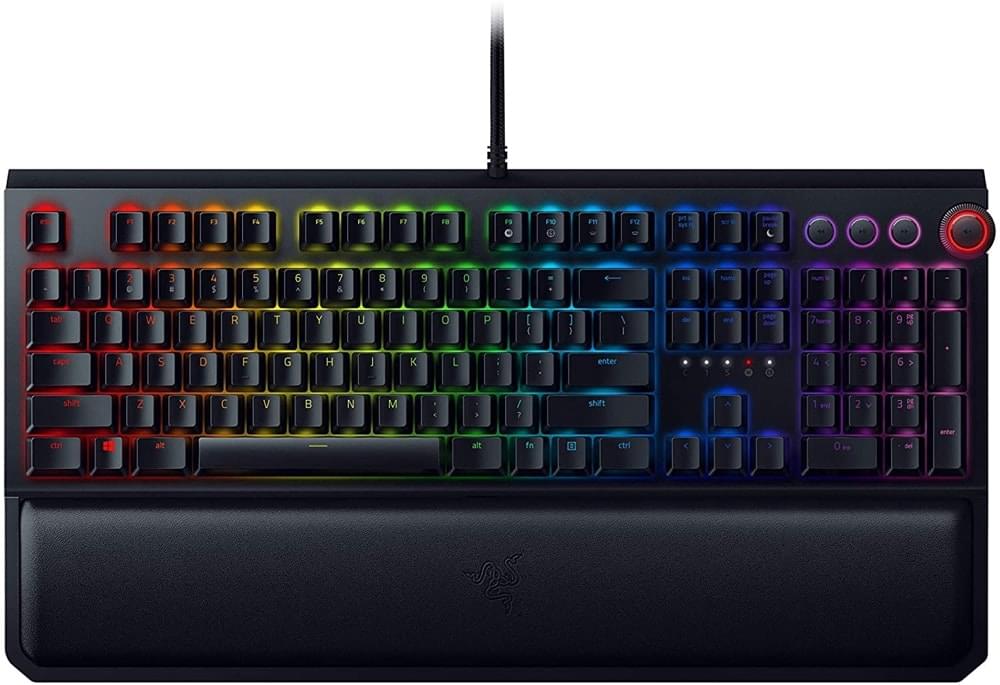
Layout: The Blackwidow Elite has a 100% layout with dedicated media controls. Other Razer models offer different layouts, such as TKL found on the BlackWidow TE Chroma v2.
Switches: Razer makes their own switches that come in linear, silent, tactile, and clicky varieties. The model linked to above comes with clicky green switches that are ideal for typing.
Macros: While the Blackwidow Elite doesn’t offer dedicated macro keys, you can add a macro or secondary function to every key using the Razer Hypershift software.
Other features: This Blackwidow Elite comes with RGB backlighting, a wrist rest, and dedicated media keys. It also offers USB 2.0 and audio ports for easy access.
Price: This keyboard understandably comes with a premium price, but it’s not the most expensive on our list.
Corsair K100 RGB Optical-Mechanical (wired)
The Corsair K100 is another premium mechanical keyboard, and it’s a better choice if you require dedicated macro keys. It’s one of the heavier keyboards due to its aluminum construction, and its optical-mechanical switches will give gamers an edge. It’s a little more expensive than the Blackwidow Elite.
- Backlit: RGB
- Wireless: No (USB)
- Keyboard layout: 100% with dedicated media keys, six macro keys, and a large volume control
- Weight: 2.89 lbs (1.31 kg)
- Price: $229.99 list, check price on Amazon
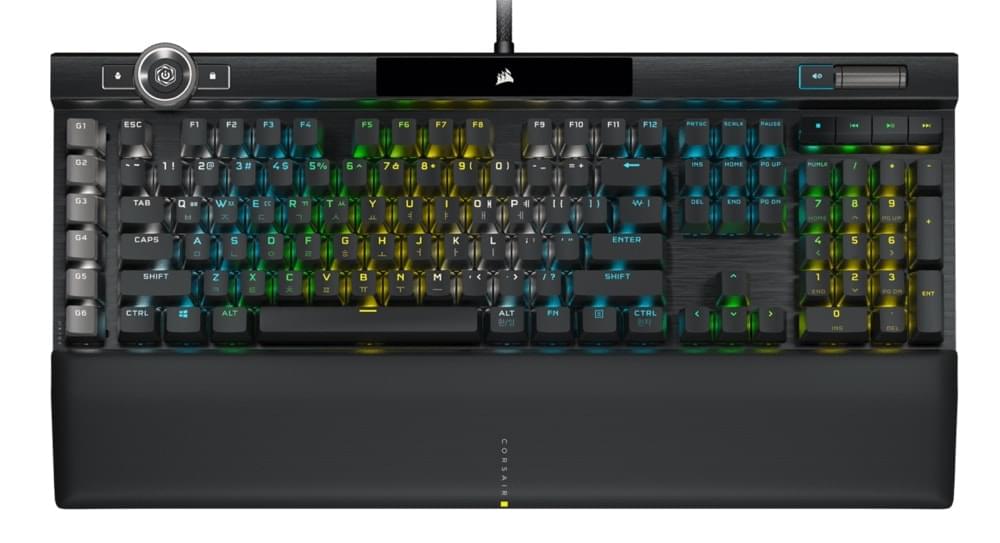
Layout: This keyboard has a 100% layout, and adds dedicated media keys, macro keys, and a large volume control. Corsair offers a wide range of mechanical keyboards and some come with other layouts. For example, the K65 and K70 models have a TKL layout.
Switches: The keyboard linked to above comes with high-speed Corsair OPX optical-mechanical switches. These register keypresses up to four times faster than mechanical switches, but probably only gamers will notice the difference. It’s also available with Cherry MX Speed mechanical switches.
Macros: The K100 has six dedicated macro keys that are fully programmable for macros and key remaps. Programming is done with the iCUE application, and special media streaming commands can be achieved with the Elgato Stream Deck software.
Other features: The K100 comes with RGB backlighting, additional USB ports for your peripherals, and a magnetic wrist rest for comfort.
Price: This keyboard is a premium product, but there are two keyboards even more expensive.
Kinesis Advantage2 (wired)
The Kinesis Advantage2 is the most unusual keyboard in our roundup due to its highly ergonomic design. It’s programmable and uses Cherry MX switches. If you can adjust to the concave layout, you might find it perfect. Otherwise, one of the the Kinesis Freestyle models may be more to your taste.
- Backlit: No
- Wireless: No (USB)
- Keyboard layout: unusual ergonomic layout
- Weight: 2.2 lbs (1.0 kg)
- Price: $349.00 list, check price on Amazon
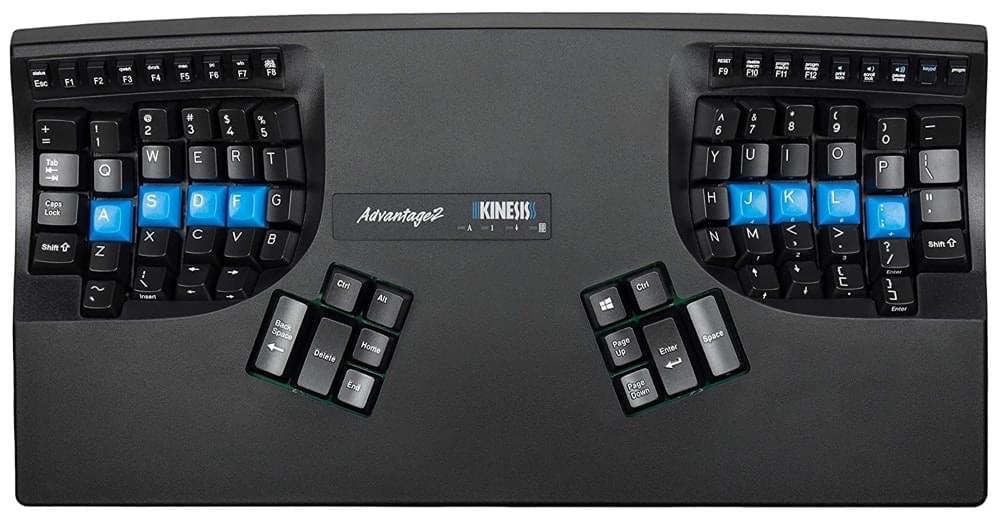
Layout: The Kinesis Advantage2 has a split keyboard layout designed for ultimate ergonomics. The concave key wells are scooped to reduce hand and finger extension. You’ll find function keys along the top and a numeric keyboard buried in the right key well.
Switches: This keyboard comes with Cherry MX brown tactile switches. The function keys are Cherry ML tactile switches.
Macros: This keyboard features on-the-fly macro recording, and you can program the keyboard using the SmartSet programming engine. You can create custom keyboard layouts or remap the keyboard to Dvorak.
Other features: Other ergonomic features include the keys being arranged in vertical columns for more natural motion, and a 20 degree tenting to keep your wrists in a more neutral position. Palm supports reduce stress on the wrists, and frequently used keys can be easily reached by your thumbs.
Price: This is the most expensive keyboard in our roundup, but if you’re looking for the ultimate in ergonomics, it’s worth the price.
The company offers a more compact and affordable model, the Freestyle. It features a split keyboard layout, and options include the wireless Freestyle2 and gaming Freestyle Edge RGB which features RGB backlighting.
SteelSeries Apex Pro (wired)
The SteelSeries Apex Pro is a great all-around mechanical keyboard. It’s sturdy yet light-weight, has RGB backlighting, and offers a comfortable palm rest.
- Backlit: RGB
- Wireless: No
- Keyboard layout: 100% with dedicated media keys
- Weight: 2.14 lbs (0.97 kg)
- Price: $209.99 list, check price on Amazon
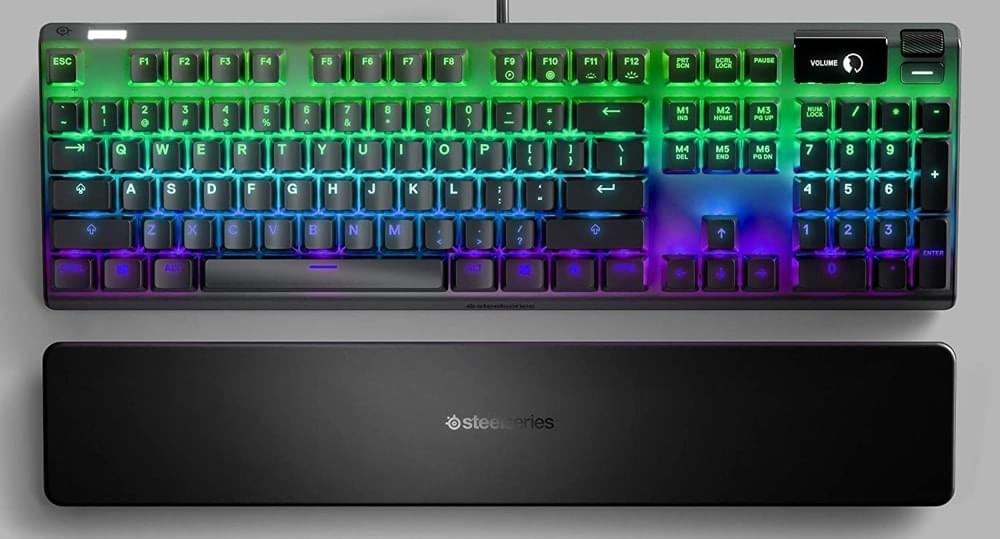
Layout: This keyboard is available in 100% and TKL layouts. It has a clickable metal roller and media key for controlling your tracks.
Switches: The model linked to above has OmniPoint Adjustable mechanical switches, which allow you to customize the sensitivity of each key. Models with standard Gateron switches are also available.
Macros: The Apex Pro allows you to save custom macros. The SteelSeries Engine software lets you customize the setup.
Other features: This model offers RGB backlighting, aluminum frame, three-way cable routing, and detachable soft touch magnetic wrist rest. An OLED smart display shows important information when adjusting settings, changing profiles, and seeing on-the-fly updates.
Price: This keyboard is in the middle of the price range of this roundup, and offers good value for money.
HyperX Alloy Elite 2 (wired)
The HyperX Alloy Elite2 is a gaming keyboard that’s also highly rated for developers. It’s the second heaviest keyboard in our roundup and is in the middle of the price range.
- Backlit: RGB
- Wireless: No
- Keyboard layout: 100% with dedicated media keys
- Weight: 3.31 lbs (1.5 kg)
- Price: $199.85 list, check price on Amazon
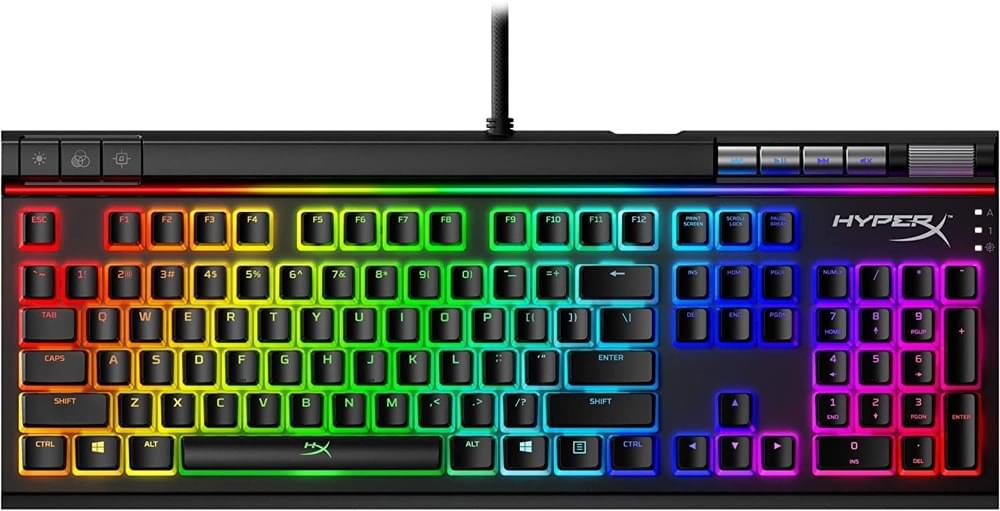
Layout: The Alloy Elite 2 has a 100% layout with dedicated media keys, quick access buttons, and a large volume wheel. Other models come in different layouts, such as the HyperX Alloy Origins Core, which has a TKL layout.
Switches: This model uses HyperX red mechanical switches with translucent HyperX Pudding Keycaps. This gives the backlighting extra brightness.
Macros: Advanced customization can be achieved with the HyperX NGENUITY software, including building macros and setting up lighting and effects per key.
Other features: The Alloy Elite 2 offers RGB backlighting, a solid steel frame, a USB 2.0 pass-through port, an optional wrist rest, and onboard memory for three profiles.
Price: This keyboard is in the middle of the price range of this roundup, and offers good value for money.
Logitech G915 (wireless)
The Logitech G915 is the best wireless mechanical keyboard on the market. It also offers low profile switches that are half as high as other mechanical keyboards.
- Backlit: RGB
- Wireless: Yes
- Battery life: 30 hours, rechargeable
- Keyboard layout: 100% with dedicated media keys and five macro keys
- Weight: 2.26 lbs (1.025 kg)
- Price: $249.99 list, check price on Amazon
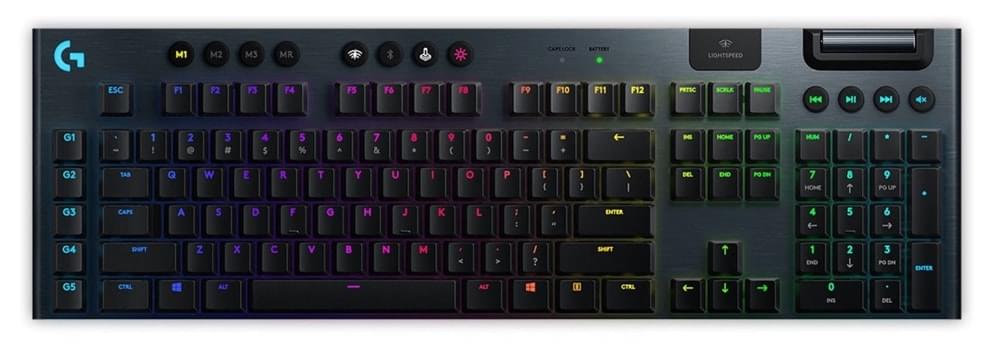
Layout: The model we linked to above has a 100% layout with dedicated media keys and G-keys for macros. A TKL model is also available.
Switches: Logitech’s low-profile mechanical gaming switches are only half the height of other mechanical keyboards, so it will be an easier transition if you’re switching from a conventional keyboard.
Macros: This keyboard offers five G-key macro keys and onboard memory for two RGB lighting profiles and three macro profiles.
Other features: It comes with RGB backlighting and a fast wireless connection with just 1 ms of latency.
Price: The Logitech G915 is one of the most expensive keyboards in our roundup, but if you’re after a sturdy, low-profile, wireless mechanical keyboard, it’s the best there is.
Keychron K1 (wireless)
The Keychron K1 offers two sets of key caps — one for Mac users and the other for Windows users. That makes it a tempting choice for Mac users. It’s also a wireless keyboard with low-profile keys like the Logitech G915, though Keychron also offer high profile and wired keyboards.
- Backlit: RGB
- Wireless: Yes
- Battery life: 10 hours, rechargeable
- Keyboard layout: TKL (87 keys)
- Weight: 2.1 lbs (0.95 kg)
- Price: $99.00 list, check price on Amazon
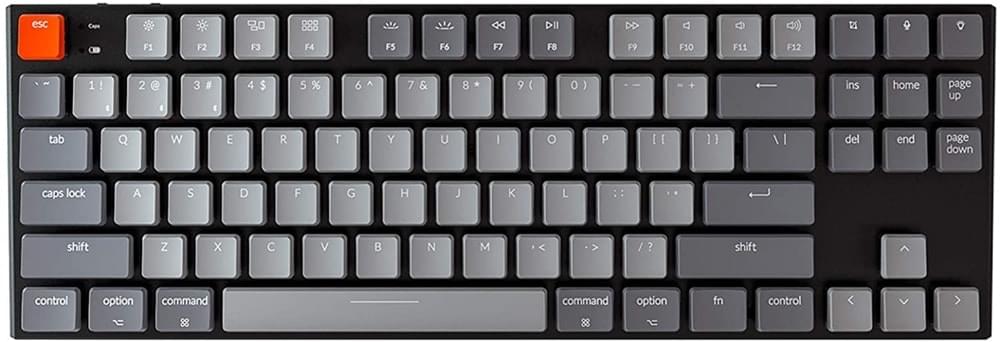
Layout: The K1 has a standard TKL layout, though there are other keyboards offered by Keychron ranging from 100% down to 60% layouts.
Switches: Gateron Red, Blue and Brown switches are available for the K1. It has low-profile switches, but other Keychron keyboards offer normal profile and optical switches.
Macros: Keychron keyboards don’t offer dedicated macro keys or come with a macro utility.
Other features: It features RGB backlighting, Mac and Windows key caps, and an aircraft-grade aluminum body.
Price: The Keychron K1 is the second most affordable keyboard in our roundup. It’s a great alternative to the Logitech G915 for those looking for a low-profile, wireless keyboard with a more accessible price.
Redragon K556 RGB (wired)
The Redragon K556 is a good choice if you’re not sure if you’re ready for a mechanical keyboard and want to test the waters with an inexpensive model. While it has lower-quality switches, it’s a sturdy keyboard with RGB backlighting and a familiar layout.
- Backlit: RGB
- Wireless: No (USB)
- Keyboard layout: 100% (104 keys)
- Weight: 2.60 lbs (1.18 kg)
- Price: $69.99 list, check price on Amazon
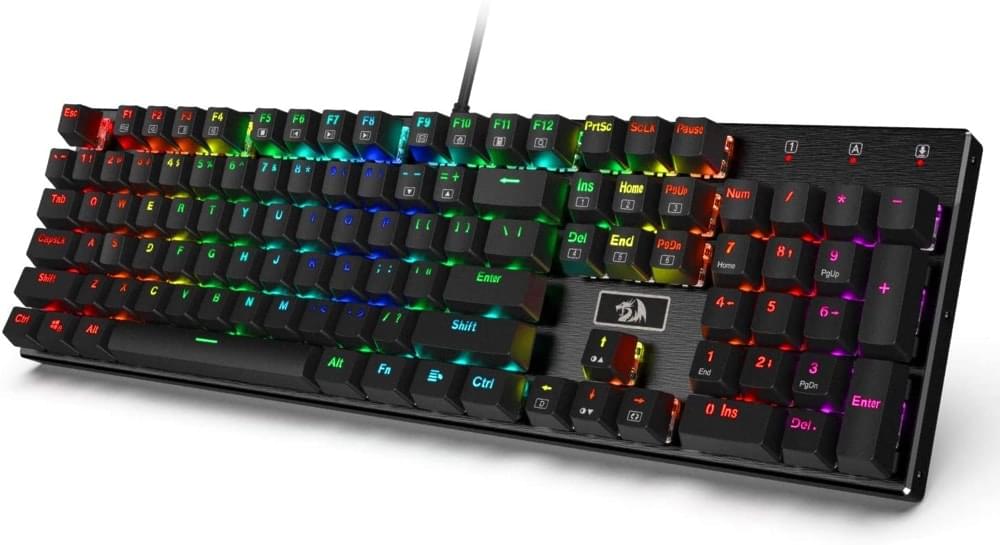
Layout: The K556 has a standard 100% layout without dedicated media or macro keys. Other models come with more compact layouts. For example, the K621 has a TKL layout with low-profile keys and Bluetooth.
Switches: The K556 comes with third-party Outemu red or brown switches. These can be switched to higher-quality Cherry switches if you decide to upgrade.
Macros: There are no dedicated macro keys or a macro utility. If that’s important to you, the Redragon K580 has both, and onboard macro recording as well.
Other features: The keyboard has a sturdy aluminum base and RGB backlighting.
Price: This is the most affordable keyboard in our roundup, but it’s not cheap. In fact, it’s built like a tank and offers good value for money. With that being said, if price isn’t your priority, the other keyboards we list are more suitable for productive programming.
So, What’s the Best Mechanical Keyboard for You?
As you can see, there is plenty of variety when it comes to mechanical keyboards, and we’ve hardly scratched the surface. Which is the right one for you? That depends on your own priorities and preferences.
The best mechanical keyboards overall are the Razer Blackwidow Elite and Corsair K100. They have a sturdy metal construction, offer additional USB ports for your peripherals, and a wrist rest for comfort. They ooze quality and have very high ratings.
If you want a mechanical keyboard that’s also ergonomic, then you need a keyboard designed by Kinesis. The Advantage2 offers almost everything a developer needs, though in a very unorthodox shape. The Freestyle2 is less unusual, more compact, and offers a wireless connection.
Speaking of wireless, the Logitech G915 is the best there is, and achieves such low latency that it’s suitable for gaming. This, combined with the low-profile switches, offers a modern typing experience that many of us are used to.
The Keychron K1 is similar, and is the only keyboard in our roundup to offer both Mac and Windows specific key caps. Its low price also makes it tempting, and the company offers a wide range of keyboards to meet most needs.
Finally, our budget pick is the Redragon K556. It uses Outemu red or brown switches, which are less expensive, but which still offer most of the benefits of more expensive mechanical switches. It’s the most affordable way to test the waters to see if mechanical keyboards are for you.


